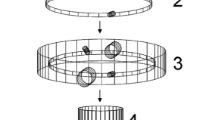Synopsis
A numerical method was developed for computing the steady-state concentration gradient of a diffusible enzyme reaction product in a membrane-limited compartment of a simplified theoretical cell model. In cytochemical enzyme reactions proceeding according to the metal-capture principle, the local concentration of the primary reaction product is an important factor in the onset of the precipitation process and in the distribution of the final reaction product. The following variables were incorporated into the model: enzyme activity, substrate concentration,K m, diffusion coefficient of substrate and product, particle radius and cell radius.
The method was applied to lysosomal acid phosphatase. Numerical values for the variables were estimated from experimental data in the literature. The results show that the calculated phosphate concentrations inside lysosomes are several orders of magnitude lower than the critical concentrations for efficient phosphate capture found in a previous experimental model study. Reasons for this apparent discrepancy are discussed.
Similar content being viewed by others
References
Appelmans, F. &De Duve, C. (1955). Tissue fractionation studies. 3. Further observations on the binding of acid phosphatase by rat-liver particles.Biochem. J. 59, 426–33.
Appelmans, F., Wattiaux, R. &De Duve, C. (1955). Tissue fractionation studies. 5. The association of acid phosphatase with a special class of cytoplasmic granules in rat liver.Biochem. J. 59, 438–45.
Beaufay, H. (1969). Methods for the isolation of lysosomes. In:Lysosomes in Biology and Pathology, Vol. 2 (eds. J. T. Dingle & H. B. Fell), pp. 515–46. Amsterdam: North-Holland.
Bone, Q. &Ryan, K. P. (1972). Osmolarity of osmium tetroxyde and glutaraldehyde fixatives.Histochem. J. 4, 331–47.
Brunk, U. T. &Ericsson, J. L. E. (1972). The demonstration of acid phosphatase inin vitro cultured tissue cells. Studies on the significance of fixation, tonicity and permeability.Histochem. J. 4, 349–63.
Chang, T. M. S. &Poznansky, M. J. (1968). Semipermeable aqueous microcapsules (artificial cells). V. Permeability characteristics.J. Biomed. Mater. Res. 2, 187–99.
Cornelisse, C. J. &Van Duijn, P. (1973a). A new method for the investigation of the kinetics of the capture reaction in phosphatase cytochemistry. I. Theoretical aspects of the formation of local crystalline precipitates.J. Histochem. Cytochem. 21, 607–13.
Cornelisse, C. J. &Van Duijn, P. (1973a). A new method for the investigation of the kinetics of the capture reaction in phosphatase cytochemistry. I. Theoretical aspects of the formation of local crystalline precipitates.J. Histochem. Cytochem. 21, 607–13.
Cornelisse, C. J. &Van Duijn, P. (1973b). A new method for the investigation of the kinetics of the capture reaction in phosphatase cytochemistry. II. Theoretical and experimental study of phosphate diffusion from thin polyacrylamide films.J. Histochem. Cytochem. 21, 614–22.
Cornelisse, C. J. &Van Duijn, P. (1974). A new method for the investigation of the capture reaction in phosphatase cytochemistry. III. Effects of the composition of the incubation medium on the trapping of phosphate ions in a model system.J. Histochem. Cytochem. 22, 110–19.
Danielli, J. F. (1958). The calcium phosphate precipitation method for alkaline phosphatase. In:General Cytochemical Methods, Vol. 1 (ed. J. F. Danielli), pp. 423–43. New York: Academic Press.
Fahimi, H. D. &Drochmans, P. (1968). Purification of glutaraldehyde and its significance for preservation of acid phosphatase activity.J. Histochem. Cytochem. 16, 199–204.
Ganote, C. E., Rosenthal, A. S., Moses, H. L. &Tice, L. W. (1969). Lead and phosphate as sources of artifacts in nucleoside phosphatase histochemistry.J. Histochem. Cytochem. 17, 641–50.
Gestrelius, S., Mattiasson, B. &Mosbach, K. (1973). On the regulation of the activity of immobilized enzymes.Eur. J. Biochem. 36, 89–96.
Goldman, R., Kedem, O. &Katchalski, E. (1968). Papain-Collodion membranes. II. Analysis of the kinetic behavior of enzymes immobilized in artificial membranes.Biochem. 7, 4518–32.
Gomori, G. (1939). Microtechnical demonstration of phosphatase in tissue sections.Proc. Soc. exp. Biol. Med. 42, 23–6.
Gomori, G. (1952).Microscopic Histochemistry, pp. 189–94. Chicago: The University of Chicago Press.
Gomori, G. &Benditt, E. P. (1953). Precipitation of Ca phosphate in the histochemical method for phosphatase.J. Histochem. Cytochem. 1, 114–22.
Holt, S. J. (1959). Factors governing the validity of staining methods for enzymes, and their bearing upon the Gomori acid phosphatase technique.Expl. Cell. Res. suppl. 7, 1–27.
Holt, S. J. &O'Sullivan, D. G. (1958). Studies in enzyme cytochemistry. I. Principles of cytochemical staining methods.Proc. R. Soc. Ser. B. 148, 465–79.
Johansen, G. &Linderstrøm-Lang, K. (1952). Liberation, diffusion and precipitation of phosphate in the Gomori test.Acta med. scand. 142,suppl. 266, 601–13.
Johansen, G. &Linderstrøm-Lang, K. (1953). Liberation, diffusion and precipitation of phosphate in the Gomori test.J. Histochem. Cytochem. 1, 442–6.
Igarashi, M. &Hollander, V. P. (1968). Acid phosphatase from rat liver.J. biol. Chem. 243, 6084–9.
Katchalsky, E., Silman, I. &Goldman, R. (1971). Effect of the microenvironment on the mode of action of immobilized enzymes.Adv. Enzymol. 34, 445–536.
Lasch, J. (1972). Theoretical analysis of the kinetics of enzymes immobilized in spherical particles. Analysis and simulation of biochemical systems, Vol. 25 (eds. H. C. Hemker & B. D. Hess).Proceedings of the Eighth Meeting of the Federation of European Biochemical Societies, pp. 295–301. Amsterdam: North-Holland/American Elsevier.
Petkau, A. &Chelack, W. S. (1972). Permeability of phospholipid membranes to inorganic phosphate.Can. J. Biochem. 50, 1030–3.
Rashevsky (1960).Mathematical Biophysics, Vol. 1, Chapter, II. New York: Dover Publications.
Stein, W. D. (1957).The movement of molecules across cell membranes, pp. 36–41. New York and London: Academic Press.
Sundaram, P. V., Tweedale, A. &Laidler, K. J. (1970). Kinetic laws for solid-supported enzymes.Can. J. Chem. 48, 1498–504.
Van Duijn, P. (1974). Fundamental aspects of enzyme cytochemistry. In:Electron Microscopy and Cytochemistry (eds. E. Wisse, W. Th. Daems, I. Molenaar & P. van Duijn) pp. 3–23. Amsterdam: North-Holland.
Author information
Authors and Affiliations
Rights and permissions
About this article
Cite this article
Cornelisse, C.J., Hermens, W.T., Tjok Joe, M. et al. A theoretical study of concentration of profiles of primary cytochemical-enzyme reaction products in membrane-bound cell organelles and its application to lysosomal acid phosphatase. Histochem J 8, 609–624 (1976). https://doi.org/10.1007/BF01003962
Received:
Revised:
Issue Date:
DOI: https://doi.org/10.1007/BF01003962




